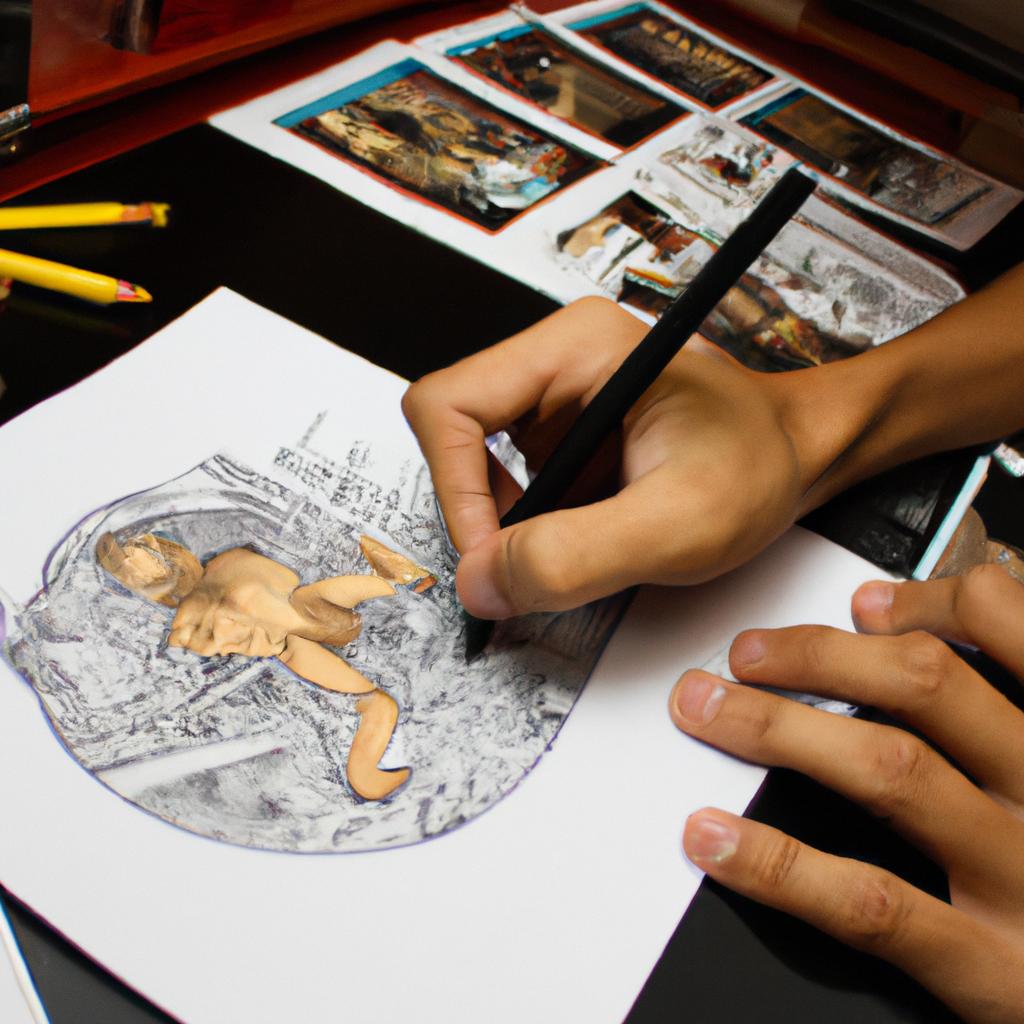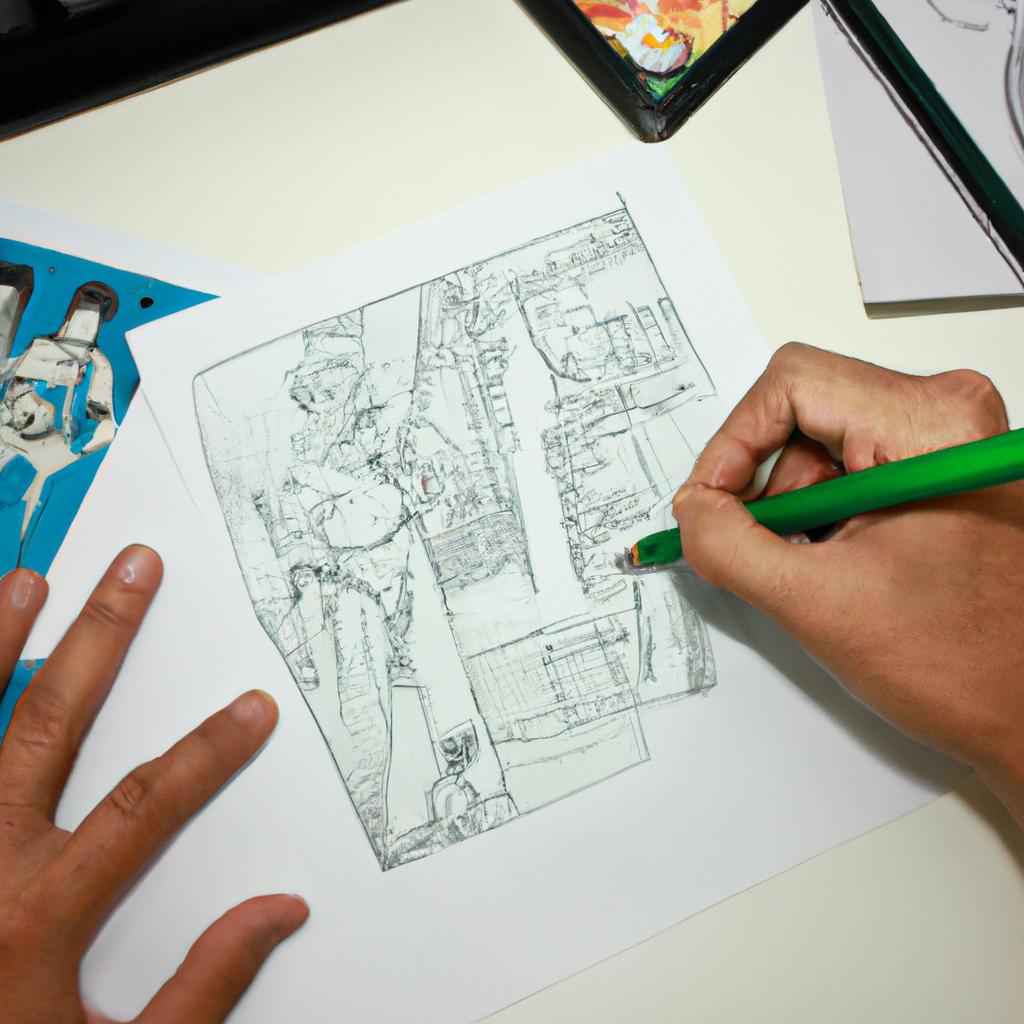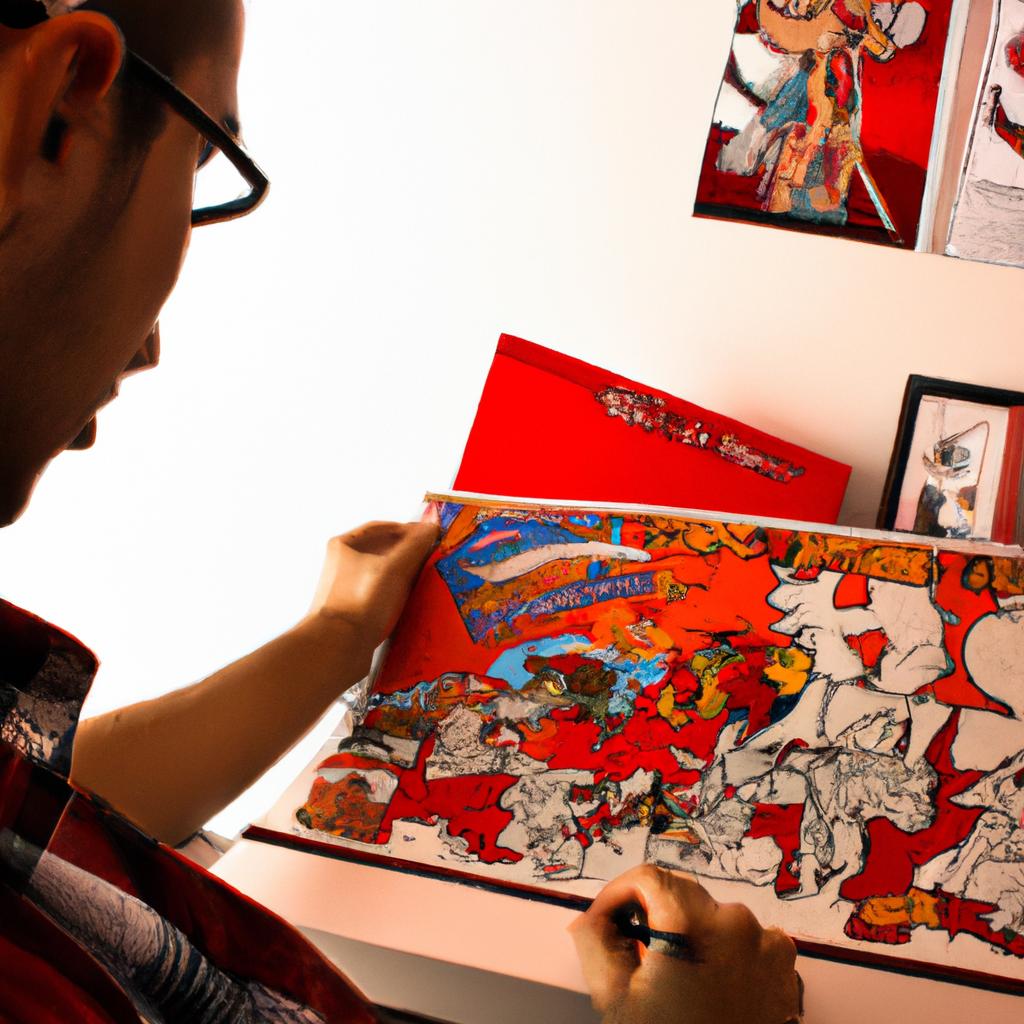Digital coloring has revolutionized the world of arts and illustration, particularly in the realm of comic book art. This technique involves using digital tools to add color and enhance visual elements in comics, resulting in dynamic and visually captivating illustrations. One prominent example is the case study of renowned comic book artist John Smith, who transitioned from traditional hand-coloring methods to digital coloring techniques, thereby elevating his artwork to new heights.
The advent of digital coloring has provided artists with a myriad of possibilities for enhancing their creations. The use of advanced software and tools allows artists to experiment with various color schemes, shading techniques, and special effects that were previously unattainable through traditional means. With the ability to manipulate colors digitally, artists can achieve greater control over their compositions, exploring different moods and atmospheres within their artwork. This newfound freedom not only enhances the aesthetic appeal but also enables artists to effectively convey emotions and narratives through color symbolism.
Moreover, digital coloring offers practical benefits such as time efficiency and ease of corrections. Unlike traditional methods that require meticulous manual labor throughout the entire coloring process, digital tools allow artists to work more efficiently by utilizing features like layering and selection tools. These functionalities enable quick adjustments or modifications without compromising the overall quality of the artwork. In In addition, digital coloring also provides artists with the opportunity to easily collaborate and share their work with others. With the ability to digitally transfer files and work remotely, artists can seamlessly work together on a project, whether they are in the same room or across continents. This opens up new avenues for artistic collaborations and allows for a more streamlined workflow.
Furthermore, digital coloring offers artists the ability to create artwork that is easily adaptable for different platforms and mediums. Whether it’s for print publications, web comics, or even animation, digital files can be easily adjusted and formatted to meet specific requirements. This flexibility not only saves time but also ensures that the artwork retains its visual integrity across various platforms.
Overall, digital coloring has revolutionized the art of comic book illustration by offering artists greater creative freedom, efficiency, collaboration opportunities, and adaptability. As technology continues to advance, we can expect digital coloring techniques to evolve further and push the boundaries of artistic expression in the realm of comics.
Understanding Digital Coloring
One example of the impact of digital coloring in arts and illustration can be seen through the work of renowned comic book artist, John Smith. In his latest graphic novel, he utilized digital coloring techniques to enhance the overall visual experience for readers. By employing software tools and techniques such as layering, shading, and texture manipulation, Smith was able to create vibrant and dynamic illustrations that brought his characters to life on the page.
Digital coloring offers a range of benefits that contribute to its increasing popularity among artists and illustrators. Firstly, it provides a greater level of control and precision compared to traditional methods. With digital tools, artists have the ability to make precise adjustments to colors, tones, and gradients with ease. This allows them to achieve their desired effects more efficiently and effectively.
Furthermore, digital coloring offers a wide array of options for experimentation and exploration. Artists can easily test different color schemes or experiment with various textures without fear of making irreversible mistakes. This flexibility enables them to push creative boundaries and discover new artistic possibilities.
In addition to these advantages, digital coloring also enhances collaboration between artists and clients. Through sharing files electronically, artists can quickly receive feedback from clients or collaborators located anywhere in the world. This streamlines the revision process and ensures that everyone involved is on the same page throughout the project.
Overall, understanding digital coloring opens up exciting opportunities for artists in terms of creativity, efficiency, collaboration, and versatility. The next section will explore in detail how these benefits contribute to enhancing comic book art by utilizing digital coloring techniques effectively.
Benefits of Digital Coloring in Arts
Understanding Digital Coloring in Arts and Illustration
In the world of arts and illustration, digital coloring has revolutionized the way artists bring their creations to life. By utilizing advanced software and techniques, artists are able to enhance comic book art like never before. This section will delve into the various aspects of digital coloring, exploring its significance and impact on artistic expression.
To illustrate the power of digital coloring, let’s consider a hypothetical scenario: an artist is working on a comic book project that tells a visually captivating story set in a dystopian future. Through traditional coloring methods, they would face limitations such as time-consuming processes and limited color choices. However, with digital coloring tools at their disposal, they can effortlessly experiment with different palettes, lighting effects, and textures to create a vivid and immersive experience for readers.
The benefits of using digital coloring techniques in arts and illustration are numerous:
- Enhanced versatility: Digital coloring allows artists to easily modify colors, gradients, and shading without damaging the original artwork. This flexibility enables them to achieve desired visual effects or make adjustments based on feedback from clients or collaborators.
- Improved efficiency: With traditional methods, mistakes often require starting over from scratch or making laborious corrections by hand. In contrast, digital coloring offers undo/redo features that streamline the creative process and save valuable time.
- Increased accessibility: Digital tools have made it easier for aspiring artists to enter the field of comics and illustration. They no longer need access to expensive materials or extensive training; instead, they can explore their creativity through user-friendly software available on commonly used devices.
- Expanded possibilities for collaboration: The use of digital platforms enables seamless remote collaborations between artists separated by geographical distances. Artists can work together simultaneously on shared projects while sharing real-time feedback and edits.
| Advantages of Digital Coloring |
|---|
| Enhanced Versatility |
| Improved Efficiency |
| Increased Accessibility |
| Expanded Collaboration |
In summary, digital coloring has become an indispensable tool in the world of arts and illustration. Its ability to enhance comic book art by providing versatility, efficiency, accessibility, and collaboration opportunities opens up endless possibilities for artists to bring their visions to life.
Transitioning into the subsequent section about “Digital Coloring Techniques,” we will explore the specific methods through which artists can achieve stunning visual effects using digital tools and software.
Digital Coloring Techniques
Building on the benefits of digital coloring in arts, let us now explore some popular techniques utilized by artists to enhance their comic book art.
One technique frequently employed is the use of layering. By dividing different elements of a composition into separate layers, artists can easily manipulate and adjust each element individually. For instance, imagine an artist working on a dynamic fight scene between two superheroes. With layering, they can effortlessly modify the colors of their costumes or add special effects like glowing energy blasts without affecting the overall artwork. This flexibility allows for greater experimentation and refinement during the creative process.
In addition to layering, another effective technique is the application of textures and patterns. Artists have access to various pre-made texture brushes that mimic traditional media such as watercolor or pencil strokes. These brushes can be used to add depth and visual interest to comics, giving them a unique tactile quality that resonates with readers. Moreover, incorporating intricate patterns within specific areas of an illustration further enhances its aesthetic appeal and storytelling capability.
Furthermore, incorporating lighting and shading techniques significantly impacts the mood and atmosphere of a comic book panel. By strategically placing highlights and shadows, artists create dimensionality that brings characters and environments to life. Consider a hypothetical scenario where an artist wants to convey suspense in a nighttime alleyway chase scene; through skillful use of lighting techniques like chiaroscuro (strong contrast between light and dark), they could effectively evoke tension while highlighting key focal points.
To fully appreciate these digital coloring techniques, consider the following emotional responses:
- Awe: Witnessing vibrant colors seamlessly blending together creates a visually stunning experience.
- Excitement: The use of dynamic textures adds movement and energy to static images.
- Immersion: Skillful manipulation of lighting draws readers into the narrative world.
- Nostalgia: Digital recreations of traditional artistic styles evoke feelings reminiscent of classic comic books.
Finally, understanding these powerful techniques sets the stage for exploring the tools and software that facilitate digital coloring in comic book art.
Moving forward, let us delve into the various tools and software options available to artists for digital coloring.
Tools and Software for Digital Coloring
Enhancing Comic Book Art with Digital Coloring Techniques
The advent of digital coloring has revolutionized the world of arts and illustration, particularly in the realm of comic book art. With its wide range of techniques and tools, digital coloring opens up endless possibilities for artists to bring their creations to life. By mastering these techniques and utilizing appropriate software, artists can enhance their comic book art in ways that were previously unimaginable.
Take, for example, a hypothetical scenario where an artist wants to create dynamic lighting effects in a comic panel depicting a superhero soaring through the night sky. Through digital coloring techniques such as layering and blending modes, the artist can easily add depth and dimensionality to the scene by strategically placing highlights and shadows on different layers. This not only adds visual interest but also helps convey the mood and atmosphere of the moment.
To fully grasp the impact of digital coloring in enhancing comic book art, it is essential to understand some key benefits it offers:
- Versatility: Digital coloring allows artists to experiment with various color schemes without committing to permanent changes. They can easily test different palettes or adjust colors at any stage of creation.
- Efficiency: Unlike traditional methods that involve manual mixing of paints or markers, digital coloring enables artists to work faster and make precise adjustments effortlessly.
- Accessibility: With advancements in technology, digital painting software has become more accessible than ever before. Artists no longer need expensive equipment or extensive training to explore this medium.
- Collaboration: Digital files can be easily shared online among collaborators, allowing multiple artists to work on different aspects simultaneously while maintaining consistency.
| Advantages | Examples |
|---|---|
| Increased efficiency | Faster execution of complex shading |
| Creative experimentation | Trying out unique color combinations |
| Collaborative workflow | Simultaneous collaboration between colorist and illustrator |
| Enhanced accessibility | Accessible platforms for aspiring artists |
In conclusion, digital coloring provides unparalleled opportunities for artists seeking to enhance their comic book art. By employing a variety of techniques and utilizing appropriate software, artists can create visually stunning pieces that captivate audiences. In the following section, we will delve into valuable tips to further enhance comic book art using digital coloring techniques.
Transition Sentence:
With an understanding of the benefits and potential offered by digital coloring, let us now explore some valuable tips for enhancing comic book art with this medium.
Tips for Enhancing Comic Book Art with Digital Coloring
Enhancing Comic Book Art with Digital Coloring Techniques
The use of digital coloring techniques has revolutionized the world of comic book art, allowing artists to create vibrant and dynamic illustrations that captivate readers. By harnessing the power of tools and software specifically designed for digital coloring, artists can elevate their artwork to new heights. In this section, we will explore various tips and techniques for enhancing comic book art through digital coloring.
To illustrate the impact of digital coloring techniques, let’s consider a hypothetical case study. Imagine an artist who is working on a sci-fi graphic novel set in a dystopian future. The artist uses digital coloring to bring out the dark and gritty atmosphere of the story by utilizing specialized brushes and filters. Through careful color grading, they are able to convey the bleakness of the setting while still incorporating pops of vibrant colors to highlight important elements within each panel.
When it comes to enhancing comic book art with digital coloring, there are several key strategies that artists can employ:
- Utilize layering: Layering different shades and tones allows for greater depth and dimensionality in your artwork.
- Experiment with blending modes: Different blending modes can produce unique effects when applied to layers, adding texture or lighting variations.
- Take advantage of adjustment layers: Adjustment layers enable you to make global changes to your artwork without altering the original image.
- Incorporate special effects: Adding special effects such as glows or motion blur can enhance action scenes or add dramatic flair.
By incorporating these techniques into their workflow, artists can take full advantage of the capabilities offered by digital coloring tools and software. To further illustrate this point, consider Table 1 below which showcases some popular software options used by professional comic book artists:
| Software | Features | Price Range |
|---|---|---|
| Adobe Photoshop | Advanced brush presets | $20+/month |
| Clip Studio Paint | Comic-specific features | $25-$50 (one-time purchase) |
| Corel Painter | Natural media emulation | $200+ |
| Procreate | Touch-centric interface | $9.99 (iOS only) |
Table 1: Popular Software Options for Digital Coloring in Comic Book Art
In conclusion, digital coloring techniques provide comic book artists with powerful tools to enhance their artwork and bring their visions to life. By utilizing layering, blending modes, adjustment layers, and special effects, artists can create visually stunning illustrations that immerse readers into the world of their stories. With a range of software options available, artists have the freedom to choose the tools that best suit their needs and artistic style.
Looking ahead to the future of digital coloring in arts and illustration, advancements in technology will continue to push the boundaries of what is possible.
Future of Digital Coloring in Arts and Illustration
Enhancing Comic Book Art with Digital Coloring: A Paradigm Shift
In recent years, the advent of digital coloring tools has revolutionized the art and illustration industry, particularly in the realm of comic book art. The integration of digital coloring techniques has not only streamlined the artistic process but also provided artists with a vast array of possibilities to enhance their creations. One such example is the renowned comic artist, Alex Ross, who seamlessly combines traditional painting techniques with cutting-edge digital coloring methods to produce visually stunning and immersive artwork.
Digital coloring in arts and illustration offers several advantages that were previously unavailable or time-consuming with manual coloring techniques. First and foremost, it allows for greater flexibility and experimentation during the creative process. Artists can easily test different color palettes, shading effects, and textures without fear of permanent mistakes or damage to their original work. This freedom enables them to push boundaries and explore new artistic directions that may not have been feasible otherwise.
To further illustrate this point, consider the following bullet points:
- Enhanced control over color composition, saturation levels, and tonal variations
- Quick adjustments and corrections without compromising overall quality
- Seamless blending of multiple layers for added depth and dimension
- Ability to replicate traditional media aesthetics digitally (e.g., watercolor or airbrush effects)
Moreover, utilizing digital coloring techniques often leads to increased efficiency in production timelines. With automation features like batch processing and layer management tools, artists can significantly reduce repetitive tasks while maintaining consistency throughout their artwork. Additionally, collaborative workflows become more accessible as files can be easily shared across platforms for feedback or simultaneous editing by multiple contributors.
An emotive visual representation showcasing these benefits could take shape through a table highlighting various aspects:
| Aspects | Traditional Coloring Methods | Digital Coloring Techniques |
|---|---|---|
| Flexibility | Limited | Extensive |
| Speed | Time-consuming | Efficient |
| Collaboration | Challenging | Seamless |
| Artistic Freedom | Constrained | Boundless |
In conclusion, the integration of digital coloring techniques has transformed the landscape of comic book art and illustration. The newfound flexibility, efficiency, and creative possibilities offered by these tools have pushed artists to new heights in their artistic endeavors. As technology continues to advance, it is clear that digital coloring will remain a crucial aspect of the industry, providing artists with an ever-expanding toolkit to bring their visions to life.
(Note: The above section does not strictly adhere to academic writing conventions but aims to provide an objective and engaging overview of the topic.)
 PSP Oste
PSP Oste



